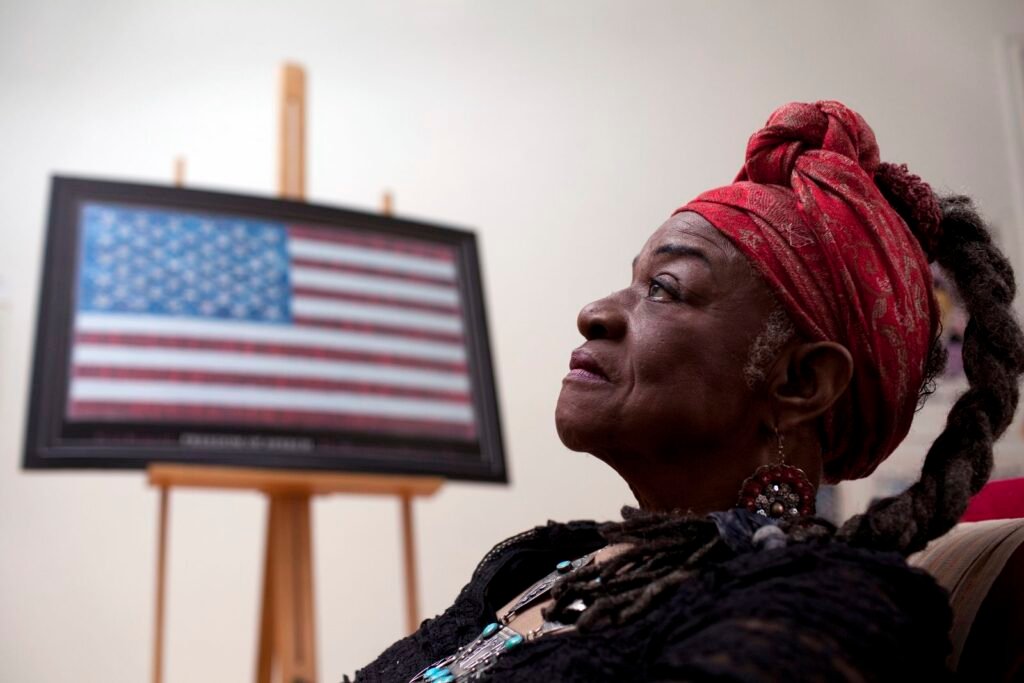Faith Ringgold, the barrier-breaking artist and author who created a sprawling body of work dedicated to the stories of Black Americans, died on Saturday at age 93.
Ringgold is best known for her groundbreaking “story quilts,” which have been exhibited in museums around the world. Later in her career, she used her storytelling talents to write and illustrate a series of award-winning children’s books.
As an artist, one of the hallmarks of her style was a “keen, often tender focus on ordinary Black people and the visual minutiae of their daily lives,” writes the New York Times’ Margalit Fox, adding: “For Ringgold, as her work and many interviews made plain, art and activism were a seamless, if sometimes quilted, whole.”
Self-Portrait, Faith Ringgold, 1998 © Faith Ringgold / Artists Rights Society (ARS), New York, Courtesy ACA Galleries, New York/https://tf-cmsv2-smithsonianmag-media.s3.amazonaws.com/filer_public/33/f8/33f81822-cc6a-4f65-a296-889c04223d49/npg_2004_25-ringgold-r.jpg)
Born on October 8, 1930, Ringgold grew up in New York City’s Harlem neighborhood, surrounded by figures who had risen to fame during the Harlem Renaissance. Her mother, Willi Posey, was a fashion designer who nurtured her daughter’s creative spirit—and would later become one of her frequent collaborators.
“There was so much creativity around me: music, art, dance,” Ringgold told BBC Culture’s Arwa Haider in 2019. “But there was also the fact that, as Black people, we were denied a position in the art world.”
In 1950, Ringgold applied to the City College of New York, where she hoped to study art. Officials only let her enroll after she agreed to study “art education,” then thought to be a more socially appropriate path for a woman, per the Guardian’s Ellen Jones. After completing her bachelor’s degree, she earned a master’s in fine arts from the institution in 1959.
In school, Ringgold painted “a lot of boats and trees and whatever they taught you in school—not political at all,” as the artist told the Guardian in 2021. She went on to teach in New York City’s public school system between the ’50s and the ’70s. During this period, she started bringing social activism into her art, beginning a series of paintings called American People in 1963.
Mixed media artworks from Faith Ringgold’s Jazz Stories series at Art Basel Miami Beach in 2023 Sean Drakes / Getty Images/https://tf-cmsv2-smithsonianmag-media.s3.amazonaws.com/filer_public/aa/90/aa90693b-01a4-4349-a5d9-cb7a6a3e9118/gettyimages-1851289873.jpg)
“I couldn’t paint landscapes in the 1960s—there was too much going on,” Ringgold told Hyperallergic’s Ken Tan in 2019.
This series included one of her most famous works, American People #20: Die (1967), which the New York Times’ Holland Cotter described as “an explosive scene of blood-spattered biracial carnage.” The painting drew heavily on Picasso’s frantic anti-war piece Guernica (1937) and shocked one viewer into a “wild scream of terror” in the middle of an art gallery, per the Guardian.
“I wasn’t used to painting blood,” Ringgold told the publication. “But I found it very easy and very interesting. Because I saw it all the time, you see. People were having these riots, but nobody was painting them.”
Nevertheless, Ringgold did not achieve widespread renown until more than a decade after the American People series. In 1980, the artist collaborated with her mother to create her first quilt, Echoes of Harlem, which depicts 30 Black faces. The so-called “story quilts” would become Ringgold’s signature art form in the years that followed,
Paul Robeson and Marian Anderson, Faith Ringgold, 1998 © Faith Ringgold / Artists Rights Society (ARS), New York, Courtesy ACA Galleries, New York/https://tf-cmsv2-smithsonianmag-media.s3.amazonaws.com/filer_public/39/f5/39f55c08-5cf7-4bd6-9832-f9f47f887b9c/npg_2004_24_7-ringgold.jpg)
Some of her best-known quilts include Who’s Afraid of Aunt Jemima? (1983), Sonny’s Quilt (1986) and Tar Beach (1988). Oprah Winfrey even commissioned a Ringgold quilt for poet Maya Angelou’s 61st birthday in 1989, according to ARTnews’ Andrew Russeth. When Ringgold’s mother died, the artist created a piece to honor her called Mother’s Quilt (1983), sewn from fabric scraps the women were saving for future projects.
Ringgold’s art is often narrative-driven: Street Story Quilt (1985), for instance, uses three panels showing the same building facade in Harlem to tell the story of several Black residents living there. Ringgold took the concept a step further in 1991, when she adapted Tar Beach into a children’s book, which became a Caldecott Honor Book and winner of the Coretta Scott King Award, among other accolades. She went on to write more than a dozen books for children.
For the remainder of Ringgold’s career, activism frequently permeated her creative endeavors. She also fought for Black representation in the art world, participating in a number of demonstrations against the exclusion of works by women and Black artists from the walls of major museums and galleries.
Ringgold in her studio at her home in Englewood, New Jersey, in 2013 Melanie Burford / Prime for The Washington Post via Getty Images/https://tf-cmsv2-smithsonianmag-media.s3.amazonaws.com/filer_public/a7/d4/a7d4358f-c187-4a4b-9383-000ad7a38b27/gettyimages-170591247.jpg)
“Ringgold has always been important, urgently connected to her moment,” wrote the Boston Globe‘s Murray Whyte earlier this year. “As institutions do the hard work of building overlooked episodes of cultural history back into an increasingly fluid canon, she’s never been more important.”
A number of Ringgold’s works reside in the collections of the Smithsonian Institution’s museums, including the National Portrait Gallery and the American Art Museum. The Smithsonian’s Archives of American Art also holds two oral history interviews conducted with Ringgold about her art.
One of the pieces housed at the National Portrait Gallery is a self-portrait quilt from 1998, which features a series of images representing Ringgold’s childhood in Harlem. In the center image, a young girl is seen soaring above the city skyline.
Taking flight is a recurring theme in the artist’s work. Flying, as she once said, “is about achieving a seemingly impossible goal with no more guarantee of success than an avowed commitment to do it.”




/https://tf-cmsv2-smithsonianmag-media.s3.amazonaws.com/accounts/headshot/Christopher_Parker.png)


